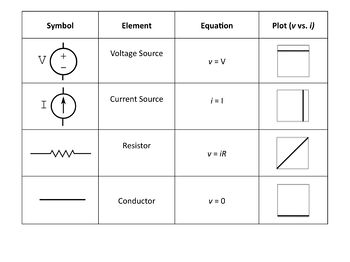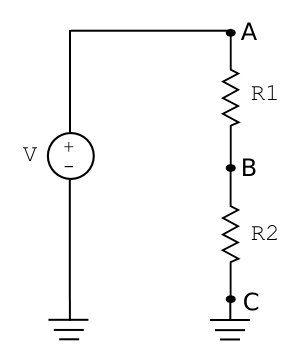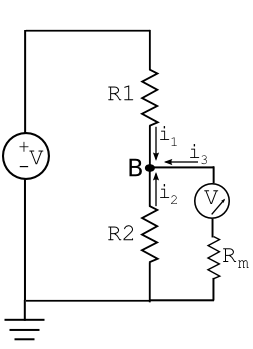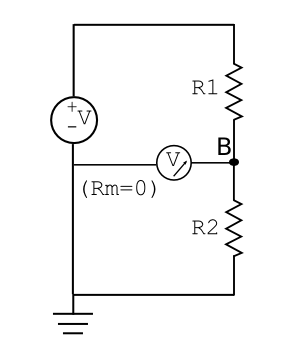Electronics primer
Circuit models
The physical quantities that characterize many types of systems are defined at all points in space and time. For example, Maxwell's equations describe the relationship between the electric field, magnetic field and charge at every point in space and time. The equations govern the operation of electric circuits. Computing the field and charge at every point is a very thorough approach to analyzing an electrical system. However, such a detailed model includes far too much information to provide a useful model for understanding most electronic systems. In many cases, analysis can be dramatically simplified by using circuit models. Circuit models characterize a system only at a small number of well-defined points by collapsing regions of space into lumped elements. A circuit model is a representation of a system that consists of a network of lumped elements connected together by wires. Regions of space that do not significantly impact system behavior are ignored.
Lumped elements are idealized abstractions of physical components, such as a resistors. Elements are bounded by terminals. Every element obeys a constitutive equation that describes the relationship between the state variables at its terminals. In elements with two terminals, one is typically designated (+) and the other (-). Each type of element has an associated graphic symbol. Symbols can be arranged in schematic diagrams to depict a system of interconnected elements. The symbol for a resistor is shown at right. It is possible to create lumped element models of many types of systems that have two state variables, including thermal, acoustic, hydraulic, and mechanical systems.
The state variables for an electric circuit are current and voltage. Current measures the flow rate of electrons through an element. A positive current flows from the plus terminal to the minus. The variable i is usually used to represent current. Voltage quantifies the electrical potential difference between two terminals. Higher voltages attract electrons more intensely and thus result in larger current flows. Voltage is usually represented by the variable v. Every two-terminal element has a single voltage across it and current flow through it.[1] The constitutive equation for an ideal resistor is given by Ohm's law, v=iR.
This page introduces the ideal electronic elements and reviews methods for solving circuits.
Review of electrical units and equations
- Electric charge is measured in Coulombs. One mole of electrons has a charge of about 96,500 Coulombs.
- Electric potential difference has the units of energy divided by charge and is measured in Volts. 1 Volt = 1 Joule/Coulomb = 1 kg m2 / sec 2/Coulomb. The variable v is most often used for voltage.
- Current has the units of charge per time and is measured in Amps. 1 Amp = 1 Coulomb / sec. [2] The variable i is normally used for current.
- Resistance has units of Ohms. 1 Ohm = 1 Volt divided by 1 Amp. Resistance is usually denoted by R
- Electric power is equal to voltage times current, P = v i. Power has units of energy per time called Watts. 1 Watt = 1 Volt x 1 Amp = 1 Joule / second.
Ideal lumped circuit elements
The table on the right shows the name, symbol, constitutive relation and i-v curve of four ideal elements: a voltage source, a current source, a resistor, and a conductor. The constitutive equation defines the relationship between voltage across and current through the element, which is plotted in the fourth column. An ideal voltage source maintains a constant potential difference across its terminals regardless of the amount of current flowing through it. Thus, its voltage versus current graph is a horizontal line. The current flowing through an ideal current source is constant no matter what potential difference is across its terminals. Ideal resistors obey Ohm’s law, v = iR, which is a sloped line on the voltage versus current graph. Ideal conductors have zero resistance. All points on a conductor have the same Voltage.
Connecting circuit elements
Networks of elements are formed by connecting terminals together with wires, as shown in the schematic diagram at right. Elements interact only through their terminals. Terminals joined together by wires are called nodes. All of the terminals connected to a node have the same voltage, which is unsurprising because they are connected by an ideal wire. Node voltage is measured with respect to a reference potential, usually called ground. The voltage across an element in a network can be found by subtracting the node voltage at its minus terminal from the node voltage at its plus terminal. Any path between two independent nodes is called a branch. Any path from one node back around to itself is called a loop.
A schematic diagram like the one shown at right is one way to specify a network of circuit element. Terminals may be shown as filled or open circles to indicate whether or not that terminal connects to another element. Open circles represent no connection. Pairs of terminals are sometimes called ports. A port may encompass a single element or multiple elements. Dividing a circuit into groups of elements that interact through their ports can be a useful way to conceptualize and analyze systems.
Series and parallel
When two elements are joined end to end, they are said to be in series. In this case, the (-) terminal of one element is joined to the (+) terminal of the second element. The current flowing through each resistor in series connection is identical. The equivalent resistance of two resistors in series is the sum of the resistances: R = R1 + R2. Voltage sources connected in series are add.
If instead the (+) terminals of the two elements are connected, as are their (-) terminals, then the elements are said to be in parallel. The voltage across each resistors in a parallel connection is the same. The equivalent resistance of two resistors in parallel is: R = R1R2/R1 + R2
Series and parallel relationships can be used to reduce complex circuits to simpler ones as an intermediate step in problem-solving.
Ground
Voltage is always measured relative to a reference point. It is useful to designate a particular node as the zero point, called the ground node. You may designate any node at all as ground; however, some choices are more convenient than others. In a circuit with a single voltage or current source, the best choice is usually the negative terminal of the source. Using this convention, all of the current flowing through the circuit eventually returns to the source through the ground node. In practice, the ground node is usually implemented as a thick wire attached to the negative terminal of the power supply.
Another possible choice of reference points is earth ground. Earth ground is the potential at which which we spend most of our existence &mdsah; the potential of a conductor driven a few feet into the soil. If you are at earth ground potential, the doorknob doesn't shock you when you go to open the door. The ground node in most circuits is usually at a potential close to earth ground, but that does not have to be the case. The third conductor on electrical plugs is connected to earth ground. Since we spend most of our time at or near earth ground potential, connecting the outer case of electrical equipment helps prevent shocks. Earth ground and the ground node may or may not be connected together.
Understanding equivalent diagram topologies and notations, part 1
A common group of elements comprises a voltage source and two resistors in series. For reasons we shall see shortly, this grouping or "primitive" is called a voltage divider. Two common ways to depict this circuit are shown below.
We can see that the voltage at node C is trivially 0, and that at node A is the maximum source voltage, because these are connected to the voltage source by ideal wires. The voltage at node B depends on the relative values of the two resistors.
As an example, let's take V = 12 V, $ R_1 $ = 200 Ω, and $ R_2 $ = 600 Ω. Each resistor is described by $ v=iR $, where i must be uniform in this purely series-connected circuit. Ohm's law also applies to the circuit as a whole when using the overall series equivalent resistance $ R_{eq} $, namely the sum of the two resistances. Thus, $ v = 12 \text{V} = i R_{eq} = i (R_1 + R_2) = i (200 + 600)\Omega $, which can be solved for i = 15 mA.
The first resistor is described by $ v_{AB}= i R_1 =15 mA * 200 \Omega $. Thus, it has an element voltage of $ v_{AB} = 3 \text{V} $, and the node joining the two resistors has node voltage $ v_B = 12 - 3 = 9 \text{V} $. Indeed, solving the second resistor equation $ v_{BC}= i R_2 =15 \text{mA} * 600 \Omega $ yields 9 V (with $ v_C $= 0 , of course).
Clearly, a voltage divider "divides" the voltage drop across resistors in series in proportion to their resistances. In sections 5.2-5.3 we will see a more universally applicable way to solve this problem, when we cannot rely on our intuition as much. Then we will imagine connecting measurement devices to the circuit and also further discuss topology.
Some other examples of topogically equivalent circuits are shown below (Fig 8).
Putting it all together: solving circuit problems
Solving problems: fundamentals/theory
Two key relationships provide the foundation for circuit analysis: Kirchoff’s circuit law and Kirchoff’s voltage law, hereafter KCL and KVL. KCL is based on charge conservation: at any node, the sum of the current magnitudes flowing in must equal the sum of the current magnitudes flowing out. When solving problems in which current directions are trivially known, this form of the law works well.
And now we see why current must be equal for elements connected in series: at the shared node, current coming out from the first element must have the same magnitude as current coming into the second element. No other branches exist at that node.
Returning to the issue of signs, current always flows from the (+) to the (-) terminal for an element, that is, from higher to lower voltage (except in a voltage source). However, the terminal definitions may not always be obvious/known in advance of solving the circuit problem. To keep signs straight, it will be convenient to have a systematic relationship between i and v signs. This relationship is described in the problem-solving section just below.
KVL is based on conservation of energy: the sum of the element voltages (potential difference across each element) around a loop is zero. Equivalently, the potential difference between the starting and ending node in a loop (that is, the same node) must be zero.
Take, for example, the three node voltage divider from section 4.3. Applying KVL directly in a clockwise direction, $ v_{AB} + v_{BC} +v_{CA} = 3+ 9 -12 =0. $ KVL is even more straightforwardly applied using node voltages. Again going clockwise, clearly node voltages $ v_A - v_B + v_B - v_C - v_A + v_C = 0 $, without even plugging in numbers.
Now we also see why voltage must be equal for elements connected in parallel: the two shared nodes form a loop, and hence the potential differences across the two elements must be identical.
Solving problems: node-voltage analysis method
One rigorous way to solve circuit problems is to write the constitutive relation for each element (B equations for B branches), every independent KCL statement (N-1 equations for N nodes), and every independent KVL statement (B-1+N equations for B branches). Then algbraic substitutions are made until every element voltage and current is known. Often it is not obvious which substitutions will most quickly yield the quantities that are actually of interest in that problem.
The node-voltage analysis method is a faster universal approach for solving circuit problems. It indirectly incorporates KVL and requires fewer KCL statements. Rarely can there be confusion about which choice of equations will quickly yield meaningful results. (For very complex circuits, however, linear rather than simple algebraic approaches may be required.)
Recall that while an element voltage is the potential difference across said element, a node voltage is the potential difference between that node and a common reference point – usually ground. (If these definitions don't sound familiar, see Figure 1 under Primary definitions and also review Connecting circuit elements.)
Working with node voltages rather than element voltages makes KVL implicit, as we saw in the voltage divider example above. The basic approach is then to write a single KCL equation per unknown node voltage, while immediately substituting in the element constitutive laws in terms of voltages and resistances.[3]
To avoid mistakes when using KCL, it is helpful to adopt a consistent way of writing the node equations. One convenient way to do this is to write an expression the current flowing into the node through each connected component, sum the expressions, and set the whole thing equal to zero. The expression for the current flowing through an element into the node is obtained by subtracting the voltage at the node under consideration from the voltage at the far end of the element (i.e. the terminal not connected to the node) and dividing by R. All you have to remember is, "the sum of the currents flowing into the node is zero."
Understanding equivalent diagram topologies and notations, part 2
Let’s return to the two-resistor voltage divider described in section 4.3 above to practice our systematic approach for solving circuits, calling the single non-trivial node of interest B for consistency. We can apply KCL to calculate it:
$ i_1 + i_2 = 0 = \frac{12-v_B}{200} + \frac{0-v_B}{600} \to \text{nominal}\ v_B = 9 \text{V}. $
Now let’s imagine connecting a voltmeter to measure the voltage at node B. To read the correct relative potential, the voltmeter must also be connected at ground. In other words, the second resistor and the voltmeter with associated resistance $ R_m $ are in parallel. Before attaching the voltmeter, the access port of interest can be shown as:
After attaching the voltmeter, three equivalent circuit diagrams depicting the system are:
The voltmeter must have a high enough resistance that it does not draw current and substantially affect $ v_B $. If instead it has a comparable resistance, say 300 Ω, let’s calculate the effect on $ v_B $ using our usual KCL approach:
$ i_1 + i_2 + i_3 = 0 = \frac{12-v_B}{200} + \frac{0-v_B}{600} +\frac{0-v_B}{300} \to \text{nominal}\ v_B = 6 V. $
This value is unacceptably far off from our nominal 9 V. However, if $ R_m $ is increased an order of magnitude, to 3 kΩ, $ v_B $is a respectable 8.57 V. (Try it!)
Wouldn't it be nice to calculate $ v_B $ for a given $ R_m $ without repeating the full calculation each time? The next section describes just such a method.
Thevenin equivalent circuits
Topological equivalence between circuits implies that wires have been moved around or added in place of shorthand. There is also such a thing as functional equivalence between circuits. In fact, any complex circuit consisting only of voltage sources and resistors can be reduced to a circuit with only a single voltage source and resistor! This equivalent circuit cannot be empirically distinguished from the multi-component one.
Let’s return to the voltage divider example with a port across the second resistor. We want to know how the circuit as a whole responds at this access port when there is no load on it, i.e., no element in which energy can be dissipated. We calculate the equivalent circuit by three steps.
First we calculate the open circuit voltage ($ V_{oc} $) at that port, namely 9 V as above in section 5.3.
Next we calculate the short circuit current. In this hypothetical, the attached voltmeter has no internal resistance and behaves as a wire (Fig 12). In turn, $ v_B $ is shorted to ground, and current magnitude is dependent only on $ R_1 $, not both $ R_1 $ and $ R_2 $. Hence, the short circuit current $ I_{sc} = 12 \text{V}/200 \Omega = 0.06 \text{A} = 60 \text{mA} $.
Finally, the Thevenin resistance $ R_{Th} = \frac{V_{oc}}{I_{sc}} = \frac{9 \text{V}}{0.06 \text{A}} = 150 \Omega $. The Thevenin equivalent circuit is shown in Figure 13.
Now how does this two-component circuit reduction help us? The voltmeter (or any element!) can be connected in series with $ R_{Th} $, and $ v_B $ calculated immediately by the simple voltage divider relation, $ \frac{V R_m}{R_{tot}}. $
An alternative and direct calculation of $ R_{Th} $ is the total resistance at the port as viewed looking into the circuit (with voltage sources changed to wires): here, $ R_1 $ and $ R_2 $ in parallel.
Alternative problem-solving strategies
Circuit problems can be approached in many ways[4] and in the interests of time we will primarily treat the approach that (nearly) universally works, namely the node-voltage analysis method described above. Let’s briefly look at one example of another approach that can be used on it's own or can simplify a complex topology before employing the node-voltage method.
Consider the circuit shown at right. The parallel resistors $ R_2 $ and $ R_3 $ can be temporarily collapsed into an equivalent single resistor. Its resistance is given by
$ R_{parallel} = \frac{R_2 R_3}{R_2 + R_3} = 200 \Omega. $
Then, the current through the purely series-connected circuit is simply
$ i = \frac{V}{R_{tot}} = \frac{V}{R_1 + R_{parallel}} $
where $ R_{tot} = 400 \Omega $ and by the voltage divider relation $ v_A $ is clearly 6 V. That is, half the voltage drop occurs across each 200 Ω resistor, the physically real one and the imaginary one (equivalent to two real ones).
We next expand the circuit to once more include the real, parallel branches. The potential difference across each branch must be the same $ v_A $, and thus the individual currents can be calculated from $ v_A =i_{branch x}R_{branch x} $.
For example, $ i_2 =\frac{v_A}{R_2} = \frac{6}{300} = 20 \text{mA} $.
As expected, $ i_2 $ and $ i_3 $ sum to the current through the first resistor.
Yet another general circuit-solving approach is applying energy conservation equations.
References
- ↑ For more about circuit assumptions and abstraction layers, see Agarwal 1.1-1.4: The power of abstraction, The lumped circuit abstraction, The lumped matter discipline, and Limitations of the lumped circuit abstraction.
- ↑ By convention, current is positive in the direction of positive charge flow, which means the electrons are actually flowing in the negative direction.
- ↑ Slightly more complex approaches must be taken for cases in which a voltage source has a negative terminal that is not connected to ground. See Agarwal 3.3.2, The node method: Floating independent voltage sources.
- ↑ Overall, see chapters 2 (Resistive Networks) and 3 (Network Theorems) of Agarwal. Section 2.4 (Intuitive method of circuit analysis: series and parallel simplification) treats series/parallel reductions, section 3.5 (Superposition) treats superposition, etc.















